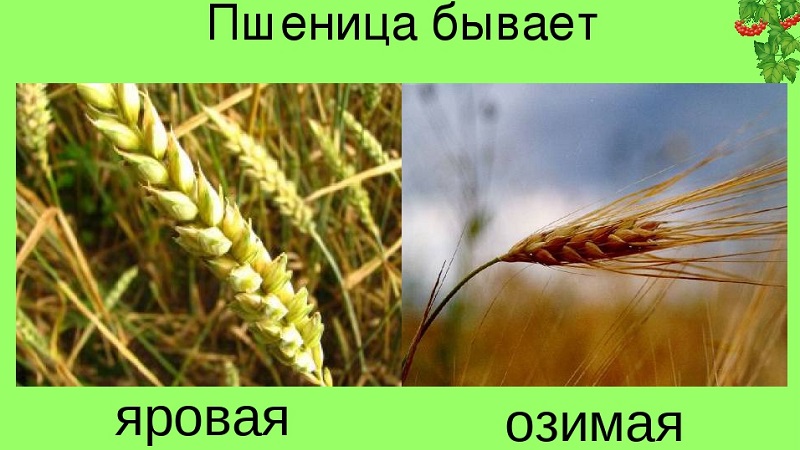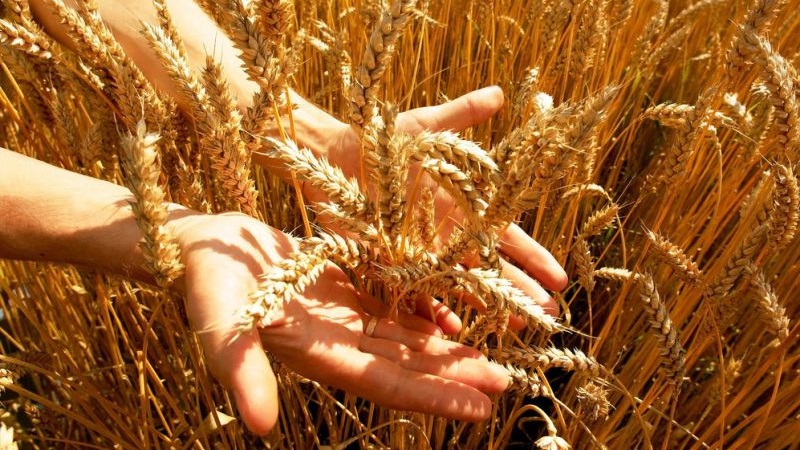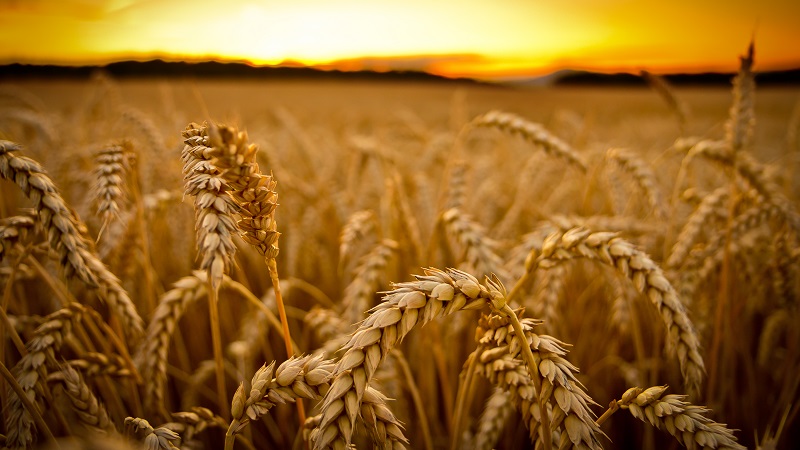What is the difference between spring and winter wheat and how to distinguish them from each other
Science describes wheat as a herbaceous plant with a height of 30 cm to 1.5 m with an inflorescence-spike up to 30 cm long and many more scientific terms that few people understand. But if we give the definition of wheat in simple terms, then this is one of the most significant products for all mankind. Flour is made from its grains, which in the skilled hands of specialists turns into white bread, bakery, pasta and confectionery. Wheat is used for the production of some high quality alcohol and in animal feed.
From our article you will learn how to distinguish winter wheat from spring wheat by grain and what are the advantages of both varieties.
The content of the article
Determination of winter and spring wheat
Regardless of the variety wheat is divided into two types: spring and winter.
Spring wheat - a herbaceous plant of the bluegrass family (cereals). A highly valuable crop is cultivated in almost all countries of the world. Spring wheat is sown in spring from March to May; during the summer months it goes through a full development cycle and ripens in autumn.

Winter wheat - a representative of an annual herb of the bluegrass family. It is sown in late summer, early or mid-autumn (depending on the region), and the harvest ripens in summer.
What is the difference between spring wheat and winter wheat
From the point of view of botany, spring and winter wheat are one and the same plant, but the biological characteristics and the cultivation process of these two species are very different. This includes cycle times and seasons, weather conditions and soil composition, climate and crop volume.
Vegetation period
Spring wheat goes through the entire cycle from sowing to harvest in an average of 100 days... This period may vary depending on climatic conditions and range from 80 to 125 days. During this time, the moisture content of the grain is reduced to about 13%. This indicator makes it clear that it is time to start harvesting.
The full growing season for winter wheat is approximately 240 to 350 days... The cycle is divided into two stages of active vegetation: autumn (about 50 days) and spring-summer (from 75 days). The rest of the time between the stages, the plant hibernates at rest.
Sowing dates
Spring wheat varieties are sown in spring, right after the snow melts and the ground warms up a little. It is necessary to sow in a short time, as long as moisture from melting snow remains in the soil.
Winter crops sow in late summer - early autumn, depending on the weather and region.
Soil requirements
For spring wheat, the optimum soil moisture is 65-75%, depending on the variety... Hard varieties require slightly more moisture than soft varieties. Spring varieties prefer slightly alkaline, neutral soil or chernozem, but not acidic soil. And the absence of weeds in the land has a positive effect on the size of the crop. This type of wheat requires foliar feeding, especially in dry conditions and with temperature changes.
For winter varieties, the most comfortable soil moisture is 70-75%... It is advisable to plant where legumes grew, maize for silage or clean fallow - a field free of crops, which is kept loose and cultivated from weeds throughout the year.
Winter wheat is not sown in marshy and peatlands, as well as in low-lying areas.
Important! On heavy clay soils, seeds are sown to a depth of about 4 cm.If the soil is sandy and prone to drought, the depth should be about 7 cm.
During the tillering period, it is necessary to fertilize the soilin order to prevent further decrease yield... The long growing season leads to the fact that winter wheat needs soil with a high content of phosphorus, nitrogen and potassium.

Weather requirement
Spring wheat, especially her soft varieties, calmly tolerates low temperatures... Seeds germinate already at + 1 ° С. The interval between sowing and emergence depends on the temperature of the soil. If the ground warms up to + 5 ° С, seedlings appear on 20-21 days, up to + 8 ° С - on the tenth, up to + 15 ° С - on the seventh. Active growth begins at a temperature of + 13 ° C.
Spring culture is able to withstand short frosts. During grain germination - up to -12 ° С, during tillering - up to -10 ° С. But at the stage of flowering and filling grain, subzero temperatures are unacceptable for the plant, as well as abrupt changes weather conditions.
Winter varieties are less weather dependent... Seeds germinate at a temperature of + 1 ... + 2 ° C, but very slowly. For comfortable germination, a temperature of + 12 ... + 15 ° C is needed. And if the thermometer shows + 14 ... + 16 ° С, seedlings will appear in 8-9 days, provided the soil is sufficiently moist.
In early spring, winter wheat is sensitive to low temperatures and sharp fluctuations. A drop in the range from + 5 ° С during the day to -10 ° С at night creates unfavorable conditions for the growth and development of this type of cereal.
The lack of snow in winter is detrimental to the plant. Whereas the level of snow cover 20-25 cm will save winter wheat even at -30 ° C.
Reference. The ideal temperature for pouring grain is + 20 ... + 25 ° С. Heat above + 35 ° C with low humidity at the flowering stage leads to the fact that the grain becomes smaller.
Appointment
Spring wheat is of two types: soft and hard... Soft is irreplaceable in flour production for baking bread, bakery and confectionery products. Solid is characterized by a high protein content and is used in the production of cereals (semolina, Artek, Poltava), as well as extra-class pasta. For people who have chosen the right food, an indispensable condition for the purchase of pasta or noodles will be the inscription on the packaging "from hard varieties wheat ".
Spring wheat bran is a concentrated feed for all types of farm animals. Hay and chaff (chaff) are also used for feed.
Most winter wheat varieties are soft... They produce the highest quality flour. The high (30%) fiber content makes it possible to bake nutritious and delicious bread and baked goods. Flour is widely used in confectionery and less often for the production of pasta.
The bran is fed to farm animals. The straw from this cereal also has nutritional value. Used as raw material for papermaking.
Yield
The amount of wheat grown depends on many factors... Usually in agriculture, they are natural and human:
- climatic conditions in the region;
- weather conditions in a particular season (drought or continuous rains);
- soil quality;
- what grew to wheat (predecessors);
- the presence of harmful insects and weeds;
- timely harvesting;
- how many seeds were sown, etc.
The yield from winter varieties is about 15-20% higher than from spring varieties... But this is if they both matured in optimal conditions for them. If the conditions were not ideal and the above factors influenced the yield, the difference in the amount of grain per hectare can be several times.

Growing regions
Russia, along with India, China and the United States - the world cultivation leader wheat.
Huge areas are sown with spring varieties in almost all regions of Russia, up to the Arctic Circle. More than 80% of the grain harvest is harvested in the Volga region, the Southern Urals, Western and Eastern Siberia and Altai.
The optimal planting time in these regions is from May 15 to May 25... If sown before this date, seedlings will be forced to grow in drought conditions, which almost always occurs in June. Sowing operations after 25 May may result in harvesting in the autumn rain.
Winter wheat varieties are sown depending on the territorystarting from August 1 and ending in October.
In the regions of the Far North - from 1 to 15 August.
Non-black earth zone (Northern, North-Western, Central and Volgo-Vyatka economic regions, Kaliningrad, Sverdlovsk regions, Perm Krai and Udmurtia) - from August 10 to 30.
The forest-steppe part of the Central Black Earth Zone and the South-East - from August 20 to September 1.
Southern steppe zone, Lower Volga region - from 1 to 20 September.
Foothill regions of the North Caucasus - from September 15 to October 5.
Taste qualities
Spring wheat is a highly valuable crop... Grain contains 25% protein, 30% gluten - these are excellent qualities for baking bread. Spring varieties are of higher quality and tastier. Hard varieties are used in the basis of pasta, as well as for the manufacture of semolina, noodles, vermicelli, flour.
How to distinguish winter wheat from spring wheat
You can distinguish winter wheat from spring wheat by external signs. But the difference between them is not very striking.

By grain
The grain of these two types varies slightly in size.... In spring it is slightly smaller than in winter. To a greater extent, the grains differ in hard and soft wheat varieties. Soft have a mealy consistency, they can be easily chewed. Shades depend on the variety and range from light beige to reddish.
Hard varieties have more elongated grainslightly glassy and really very hard.
In appearance
Externally, wheat varieties also differ little from each other.. Ear spring is tighter. Its color may depend on the name of the variety. In spring, it can be gray, gold, beige or light burgundy.
Winter varieties differ from spring varieties by the presence of awns on the ears.
Which wheat is better
Talking about which wheat is better or worse is not entirely correct. Each species has advantages.
Spring wheat varieties are soft and hard... They are unpretentious in terms of weather conditions and practically do not crumble. The plant of this species is less susceptible to diseases and is very resistant to pressure. pests... During the pouring period, the grain is resistant to dry winds (strong winds during heat and drought). The grain of spring wheat is of high quality, so the baking properties are better.
Spring varieties are often used as a safety net in the areas of cultivation of winter varieties in case of poor wintering of the latter.
Winter wheat has only soft varieties in its "assortment"... But she also has a number of advantages in stock. The main thing is a higher yield, subject to the cultivation technology. Winter varieties tolerate sharp changes in weather better, ripen earlier (taking into account the sowing time) and are stored longer.
Conclusion
The main differences between spring and winter wheat exist in relation to external factors (weather, soil, calendar, adherence to technology) and in biological characteristics (protein and fiber content, the purpose of these cereals, etc.). But despite all the differences, advantages and disadvantages, all varieties of wheat are vital for humans.